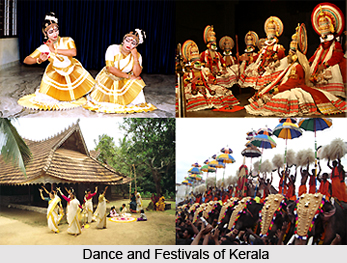Culture of Kerala is quite affluent and rich. The cosmopolitan populace of Kerala has helped in defining the culture of Kerala. It is the habitat of various Dravidian races, Hindus and Muslims. The multiple cultural moulds, adopted by the Keralites, beautify the whole of cultural heritage. Culture of this state has, thus, become a conglomeration of diversified yet robust, socio-ethnic practices and norms, nicely manifested in its elements. Music, dance, festivals, cuisine and lifestyle of Keralites testify the exuberance of culture of Kerala. The famous pantomime dance-drama, Kathakali, the Sopanam style of music, the contributions of Swathi Thirunal and Raja Ravi Verma in the realms of music and painting respectively are some of Kerala`s unique contributions Indian ethos.
Festivals of Kerala
The colourful festivals celebrated by the Keralites are an integral element of culture of Kerala. Kerala is a land of numerous temples whose premises are transformed into festival grounds where thousands of people participate with great joy and enthusiasm. Although the festivals commemorate worship of gods and religious beliefs, these events are turned into social events, rich in fun and frolic. No festival feting is fruitful without an elephant pageant and this makes the festivals of Kerala a visual treat.
 Music and Dance of Kerala
Music and Dance of Kerala
As far as the splendour and creativeness of the music and dance forms are concerned, Kerala remains invincible. Kerala`s folk music, though not refined, is rich with a rugged beauty with its rhyme and rhythm. These are mostly devotional in nature, like the Sarpapattu, Bhadrakalipattu, Ayyappanpattu etc. Among the instrumental performances, Thayampaka, Panchavadyam and Kelikottu deserve special mention. The chenda and chengala are some of the typical percussion instruments of Kerala.
Performing art forms like Kathakali, Mohiniattam are integral parts of the culture of Kerala. Mohiniattam is known as the dance of the ethereal temptress. The people of Kerala cherish martial art forms and Kalaripayattu is one such example. The rulers initiated this art style. It postulates fighting with weapons and doing acrobatic acts and practices. Folk dances and its performing styles are vibrant; Theyyam, Thiruvathirakali and Kaikotikalli are some of the examples of popular folk dance. The culture of Kerala also constitutes of several tribal art forms.
Literature of Kerala
Kerala has its own tradition in the field of drama, which is intimately bound up with the origin, and growth of the art form, Koodiyattam. A very decisive phase in the evolution of modern Kerala drama began with the composition of a series of short plays with historical themes by C.V.Raman Pillai. Malayalam is the official language of the state. Malayalam literature, too, is endowed with talents and creativity. The marvellous works of 14th century Niranam poets commemorate the aurora of both modern Malayalam language and indigenous Keralite poetry. The triumvirate of poets has discerned Keralite poetry from primitive sophistication thus contributing to its lyrical style.
 Cuisine of Kerala
Cuisine of Kerala
Cuisine is a salient feature of culture of Kerala. The cuisine here is hot and spicy and the Keralites love to experiment with the dishes. The food is aromatic and seasoned. Rice and fish are staple food in Kerala. Coconut is widely used in every sort of dish; ample use of chillies, curry leaves, tamarind, hing is also made. A variety of deserts also form an integral part of the cuisines of Kerala. Different types of tasty cakes are prepared here such as Appam and Puttu.
Thus, it can be said that the culture of Kerala has invariably savoured a rich influence and support from its patrons starting from the ancient kings who governed the state to the democratic governments of the later period.






